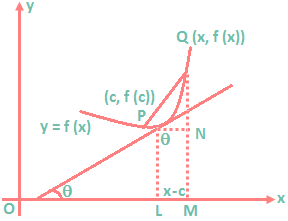If y = f(x), then dy/dx the derivative of y with respect to x, is itself, in general or function of x and can be differentiated again. To fix up the idea, we shall call dy/dx as the first order derivative of y with respect to x and the derivative of dy/dx w.r.t. x as the second order derivative of y w.r.t x and will be denoted by d²y/dx², similarly the derivative of d²y/dx² w.r.t. x will be termed as the third order derivative of y w.r.t. x and will be denoted by d³y/dx³ and soon. The nth order derivative of y w.r.t x will be denoted by dⁿy/dxⁿ. If y = f(x) then the other alternative notation for dy/dx, d²y/dx², d³y/dx³, …, dⁿy/dxⁿ are y₁, y₂, y₃, … yn.
If y = f(x) then the other alternative notation for dy/dx, d²y/dx², d³y/dx³, …, dⁿy/dxⁿ are y₁, y₂, y₃, … yn.
y’, y’’, y’’’, … y(n)
Dy, Dy², D³y, …, Dⁿy
f’(x), f’’(x), f’’’(x), … fⁿ(x)
The values of these derivatives at are denoted by yn (a), yⁿ (a), Dⁿy (a), fⁿ (a) or \(\,{{\left[ \frac{{{d}^{n}}y}{d{{x}^{n}}} \right]}_{x=a}}\).
Examples: If x = sinθ, y = cospθ prove that (1 – x²) y₂ – xy₁ + p²y = 0, where y₂ = d²y/dx² and y₁ = dy/dx.
Solution: We have,
x = sinθ and y = cospθ
∴ \(\frac{dy}{dx}=\frac{\frac{dy}{d\theta }}{\frac{dx}{d\theta }}=\frac{-p\sin p\theta }{\cos \theta }\),
⇒ \(\,\frac{-p\sqrt{1-{{\cos }^{2}}p\theta }}{\sqrt{1-{{\sin }^{2}}\theta }}\),
⇒ \(\frac{dy}{dx}=\frac{-p\sqrt{1-{{y}^{2}}}}{\sqrt{1-{{x}^{2}}}}\),
⇒ \({{\left[ \frac{dy}{dx} \right]}^{2}}=\frac{{{p}^{2}}\left( 1-{{y}^{2}} \right)}{\left( 1-{{x}^{2}} \right)}\),
⇒ \(\left( 1-x \right){{\left[ \frac{dy}{dx} \right]}^{2}}={{p}^{2}}\left( 1-{{y}^{2}} \right)\),
Differentiating both sides w.r.t. x we get
⇒ \(\left( 1-{{x}^{2}} \right)2\frac{dy}{dx}\frac{{{d}^{2}}y}{d{{x}^{2}}}-2x{{\left( \frac{dy}{dx} \right)}^{2}}={{p}^{2}}\left( 0-2y\frac{dy}{dx} \right)\),
⇒ \(\left( 1-{{x}^{2}} \right)\frac{{{d}^{2}}y}{d{{x}^{2}}}-x\frac{dy}{dx}+{{p}^{2}}y=0\).
